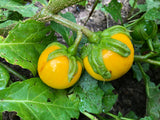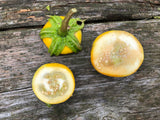Gboma (Eggplant Leaf)
Solanum macrocarpon
Please note: this listing is for SEEDS, not fresh eggplants!
Gboma greens are the bitter and nutritious leaves of a West African cousin of the eggplant. They are eaten in West, Central, and East Africa, as well as Southeast Asia. Gboma is named for a village in Liberia.
Our original seeds came to us from William Woys Weaver, with the Togolese name Gbognome (often spelled Gbogname). He received his seeds from a collector in Australia. Weaver featured this hard-to-find vegetable book 100 Vegetables and Where They Came From.
This plant grows much like a short eggplant: 2-4' tall and bushy, with round green fruits that turn yellow when the seeds are ripe for saving. Harvest leaves as soon as they are large enough to cook with! You can also eat the stems and flowers, as well as occasional fruits.
We found one delicious sounding sauce recipe in an article called "La Feuille De Gboma, Injustement Appelée « Épinard »" or "The Gboma Leaf, Unjustly Called « Spinach »". Another sauce recipe we found (also in French) features mutton, tomatoes, and egusi. See YouTube video "Sauce Gboman (sauce épinards)".
Rose Nzapa-Ayeke from New Roots Community Farm in the Bronx, New York is from Central African Republic, and she calls this vegetable simply "Feuille d'Aubergine" or Eggplant Leaf.
Here is Rose's recipe:
- Cut up leaves (like you would callaloo) and wash in a solution of cold water and baking soda; then rinse.
- Boil leaves in water and salt (to taste) until soft/cooked.
- Drain and press out excess water.
- Sauté with tomatoes etc. or cook with a peanut sauce; or you can add meat or fish. Rose likes to add pistachios from her home country to her recipe.
Days to Maturity: 70-90
Seeds per pack: 65
Germination rate: 93% on 11/06/2025
Planting / harvesting notes
These are heat-loving and seeds should be started indoors about 1/4" deep, about 8 weeks before the last frost. Transplant into garden well after the danger of frost. The growing characteristics are similar to most eggplants. The plants reach about 2-4 feet tall and should be planted 12-18 inches apart. They need full sun and fertile soil. Harvest leaves (and even stems and flowers!) when they look spinach-sized, or wait until they approach the size of a small collard green
Seed keeping notes
Eggplants are generally self-pollinating, though we isolate different varieties of the same species by 300 feet, in hopes that flying insects will not cross pollinate them unexpectedly. That said, this eggplant species is different from those that produce edible fruits, and so hopefully it will not cross-pollinate easily. Eggplant seeds are ripe when the fruits have turned another color, in this case bright yellow. Cut the fruit, scrape out seeds (perhaps through a heavy-duty screen) into a vessel, add a little water (1-2" is probably plenty) to your seeds and pulp to keep them from drying out, and allow them to ferment away from direct sunlight. Fermentation is not necessary with eggplants, but it makes seed cleaning a bit easier. Ideally, you will stir the concoction every day for 3-5 days. In the end, add more water to fill the vessel, stir one final time, and allow to settle. Pour off the floating material and then strain the seeds through a strainer. Sometimes, you will need to add more water and pour off the floating material several times until the water is clear and you can see the seeds sunken at the bottom. Squeeze dry the strained seeds in a towel, and then lay out to dry on a labeled screen or paper product in a ventilated place away from direct sunlight for a week or two.











